You’ve been working on a complex multi-team project and are almost at the finish line. Suddenly, the client gets in touch to say they want to take a different direction. If this resonates with you, adopting an Agile project management methodology can help you rapidly adapt and pivot without wasting resources.
But is it right for your project? Our guide breaks down the basics of Agile, including best use cases and examples and how to get started planning your Agile project management on monday dev.
Try monday devWhat is Agile project management and what is it used for?
Agile project management is an incremental, iterative approach to delivering a project throughout its life cycle. Iterative processes are commonly used in software development projects because they promote speed and adaptability. Agile teams work simultaneously on different project stages, called iterations or Agile sprints. These enable you to problem-solve and make continuous revisions as you respond to outcomes, customer feedback, and results in real time.
While Agile originated in software development, it’s now used across industries and project types. It’s especially effective when:
- Project requirements are likely to change
- Fast iteration and delivery are important
- Stakeholder feedback is needed at multiple stages
- The project is complex or cross-functional
- Teams want to reduce risk and adapt as they go
From product development and marketing campaigns to UX design and IT operations, Agile helps teams stay flexible, aligned, and focused on delivering value continuously. Let’s take a closer look at how Agile works in different real-world scenarios.
Agile project management examples
Agile can be applied in a range of industries and workflows. Here are a few practical examples:
- Website development: A cross-functional team building a new website might break the work into 2-week sprints. In each sprint, they gather requirements, write a website brief, design key pages, develop features, and test functionality. After reviewing feedback and site performance, they adjust priorities for the next sprint, continuing this cycle until launch.
- Marketing campaign: A marketing team launching a new campaign could use Agile to work in weekly sprints, rapidly producing and testing creative assets, gathering performance data, and refining messaging before rollout at scale.
- Product prototyping: A hardware or consumer tech team might apply Agile to prototype new features in stages. After each iteration, customer or stakeholder feedback helps shape the next version, reducing the risk of building something misaligned with market needs.
What are the 4 key Agile project management values?
The following 4 values drive every decision made under the Agile project management framework:
- Individuals and interactions over processes and tools: Agile emphasizes people over rigid systems — valuing collaboration and communication across the team.
- Working software over comprehensive documentation: Delivering functional results matters more than perfect documentation. Agile teams prioritize progress over paperwork.
- Customer collaboration over contract negotiation: Agile encourages active customer involvement throughout the project, rather than limiting feedback to fixed milestones.
- Responding to change over following a plan: Agile teams adapt quickly to feedback and evolving requirements instead of sticking to a fixed roadmap.
Want to go deeper? Read our full guide on Agile values.
What are the guiding principles of Agile project management?
The Agile Manifesto, which is the primary document outlining this Agile methodology, lists the 12 guiding principles of Agile project management:
- Satisfy the customer: Gear everything toward the needs of your target market.
- Embrace change: Even shifts late in development can give your product or service a competitive edge.
- Deliver working versions frequently: Little and often is the rule, so stay focused on completing iterations rather than finished products.
- Bring business and technical people together: Any disconnect between departments leads to misalignment between your products and target audience.
- Motivate, trust, and support your team members: Provide a supportive environment for your team to excel.
- Engage in face-to-face conversation: Regular feedback is at the heart of Agile.
- Measure progress with working versions of the final product: Course-correct as needed.
- Encourage sustainable development: Ongoing progress over the long term beats hackathons.
- Pay attention to technical excellence: Good design enhances agility.
- Keep it simple: Focus on creating a minimum viable product (MVP). Don’t waste time building a huge product with lots of features if your customer only needs the basic version.
- Use self-organizing teams: Autonomy leads to more motivated and productive employees.
- Regularly reflect and review: You can’t learn or progress without evaluating your workflow.
What do these values look like day to day? Check out our complete guide to the 12 Agile principles.
What are the benefits of Agile project management?
Choosing the right project management approach can have a big impact on your team’s success. Agile offers a modern, flexible alternative to rigid planning structures — one that’s designed for fast-moving teams, evolving priorities, and customer-first thinking. Here are 5 key benefits of Agile project management:
1. Boost customer satisfaction
Customer satisfaction is the end goal of any project. Agile supports this by enabling consistent communication, rapid delivery, and ongoing improvements.
Agile is inherently more customer-centric than linear approaches like Waterfall. Frequent, incremental releases keep clients engaged and reduce frustration. Rather than waiting months for a full product, customers get continuous updates, faster feedback loops, and a greater sense of progress.
2. Adapt quickly to change
In traditional, linear projects, completed stages are often locked in, leaving little room for midstream changes. This isn’t the case in Agile project management, where change is readily embraced.
This is a huge benefit since projects are dynamic and requirements constantly change, so clients can get their adjustments implemented within a couple of weeks. This also reduces risk as you’re working with actual conditions and requests rather than predictions.
3. Use resources more efficiently
Catching the need to change a project at the right time can save considerable time and money since teams can quickly make adjustments without scrapping work or starting from scratch.
4. Improve collaboration
Agile fosters strong collaboration across departments. Regular check-ins and clearly defined roles help team members stay aligned, support one another, and solve blockers quickly. The nature of the methodology encourages conversations and check-ins, which breed creativity and innovation.
5. Accelerate time to market
Agile enables you to launch faster by delivering value in every iteration. Each sprint results in something potentially shippable, allowing you to gather feedback, test hypotheses, or start acquiring users earlier.
If these benefits align with your goals, the next step is choosing the right Agile framework to guide your team.
7 Agile methodologies and frameworks
In project management, a methodology provides a structured, prescriptive set of processes and rules for how projects should be managed from start to finish. In contrast, a framework offers a flexible structure or set of guidelines that teams can adapt to their unique needs, allowing for creativity and customization within a defined boundary.
1. Scrum
Scrum is an Agile framework for managing product development and other knowledge work, emphasizing the breaking down of projects into iterative sprints. According to the 17th State of Agile Report, Scrum is the “most popular framework” in Agile, with 63% of respondents using it.
It’s experimental, allowing teams to create a hypothesis of what they believe will work, try it, reflect on the experience, and adjust accordingly. Larger project teams are broken into smaller Scrum teams, which include a Product Owner who represents the business’s interests and a Scrum Master who works to minimize roadblocks that prevent work from being completed. These individual teams self-organize and work in a Scrum sprint that lasts 1 to 4 weeks.
Want to learn more? See how Scrum compares to other Agile project management methodologies.
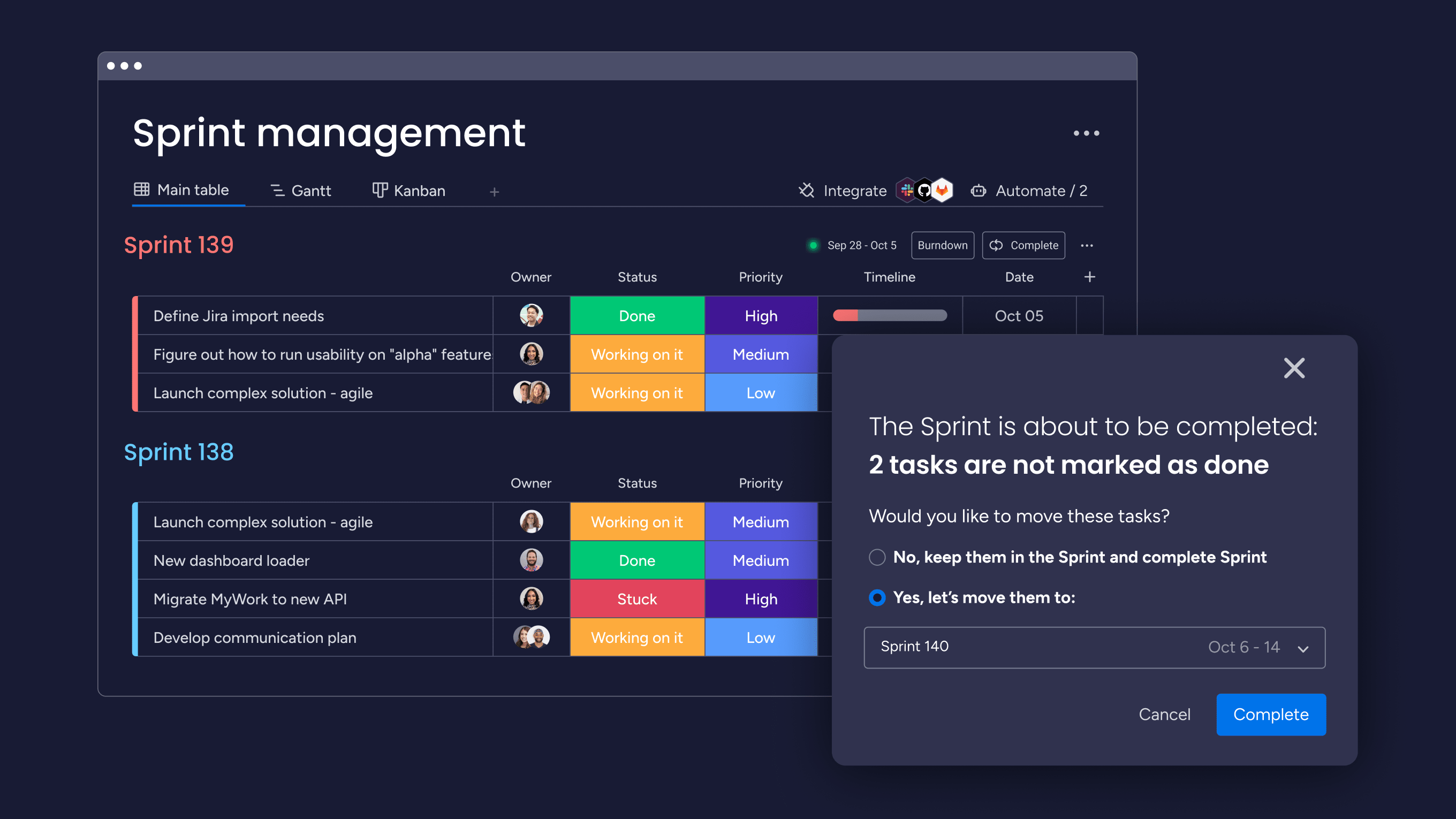
2. Kanban
The popular Kanban framework takes a visual approach to organizing projects and requires real-time communication into capacity and full project transparency. Work items are represented visually on cards, allowing team members to see the state of every piece of work at any time. Instead of working in sprints, teams work together to improve the product continuously. At the core of this framework is a Kanban board that outlines a logical workflow for fixing issues or adding features.
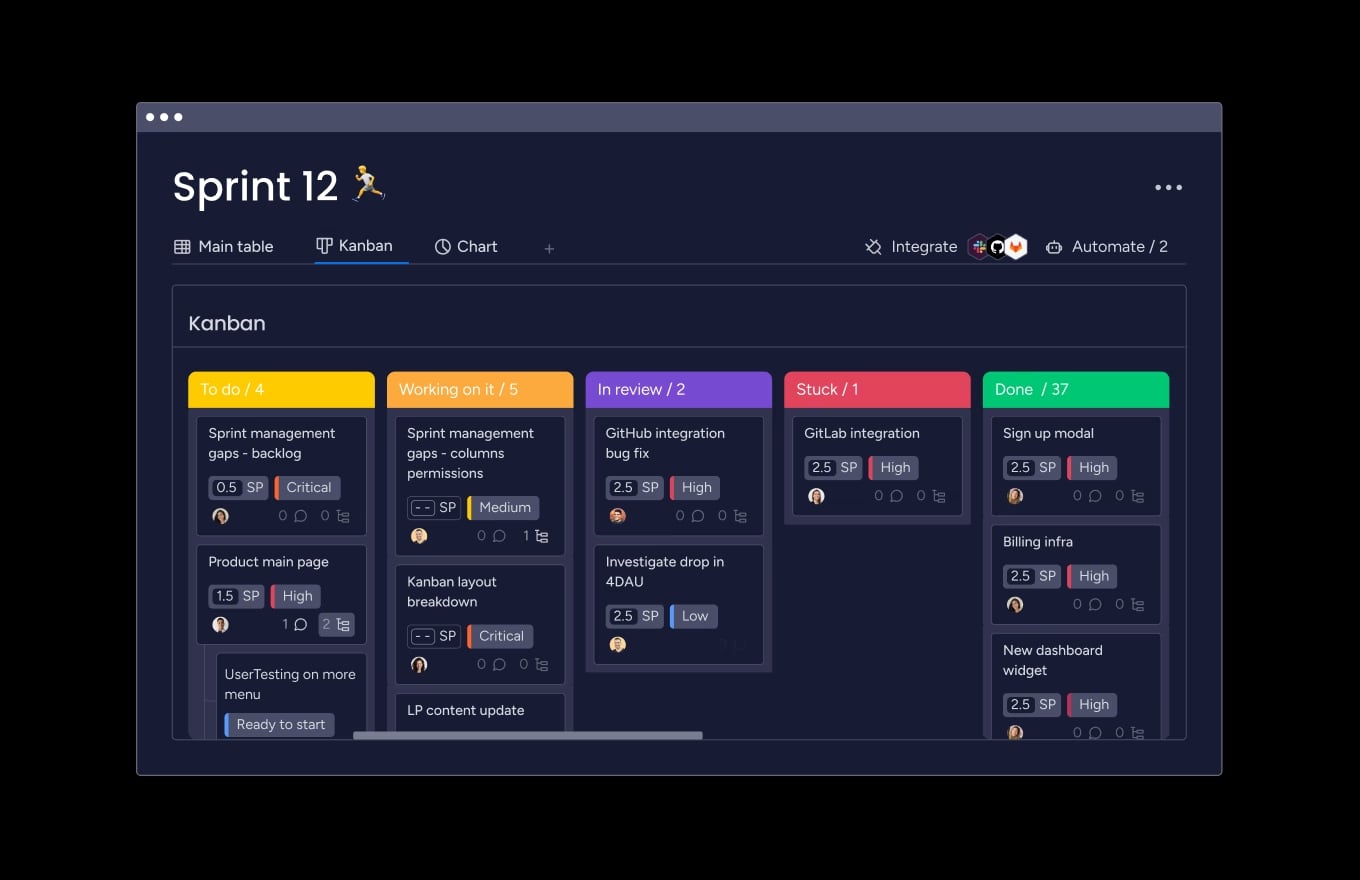
3. Extreme programming (XP)
Extreme programming (XP), a methodology used to produce higher-quality software quickly, emphasizes customer satisfaction, technical excellence, and teamwork. The core practices include test-driven development, simple design, refactoring, continuous integration, pair programming, and coding standards. This approach is popular for software development projects because it focuses on building the right product quickly and uses checkpoints to course-correct as needed.
4. Feature-driven development (FDD)
Feature-driven development (FDD) focuses on releasing features incrementally. It is often employed for large-scale software projects where the customer is uncertain about their needs until they experience them firsthand. FDD starts with a “big picture” design that sets the stage for the project. Then, teams work in short cycles to deliver small chunks of functionality. After each cycle, review meetings ensure everyone is on the same page and the customer feels the project meets their objectives.
5. Lean
Lean project management applies lean manufacturing principles to enhance project management, focusing on reducing waste, optimizing collaboration among teams, and aligning efforts toward a common goal. It’s often used in highly regulated industries where compression and speed of delivery are essential. Key practices include continuous integration, small batch sizes, customer feedback loops, and working in cross-functional teams.
6. Adaptive software development (ASD)
Adaptive software development (ASD), built upon the earlier Agile methodology of rapid application development (RAD), works best in a rapidly changing environment. It’s popular among startups that want to respond to customer and stakeholder feedback quickly.
The cycle is continuous and involves gathering customer feedback, analyzing the results, making changes to the product or process, testing the new approach, and repeating the process. The core practices of adaptive software development include risk management, customer feedback loops, rapid prototyping, evolutionary design, and iterative development.
7. Adaptive project framework (APF)
The adaptive project framework (APF) is a flexible, client-driven project management approach designed to accommodate change and uncertainty. Unlike traditional methods, APF breaks projects into iterative phases, allowing teams to adjust plans and priorities in real time based on stakeholder feedback and evolving requirements. This makes APF especially effective for projects with clear goals but undefined solutions, as it emphasizes collaboration, continuous learning, and the ability to pivot direction as needed.
Not sure which is right for you? Learn more about the best project management methodologies.
What are the primary responsibilities of Agile project managers?
For Agile teams to be successful, they need a project manager who embodies the Agile foundations of flexibility, collaboration, and efficiency. Some responsibilities specific to Agile project managers include the following:
Agile project estimating
Agile project estimating refers to breaking up a project and estimating how much time and resources each task will consume. Because of an Agile project’s inherently flexible nature, these estimates are often adapted and produced throughout a project’s life cycle. Agile project managers commonly use the system of story points, which measure a task’s effort and difficulty on a relative scale, to produce more accurate estimations.
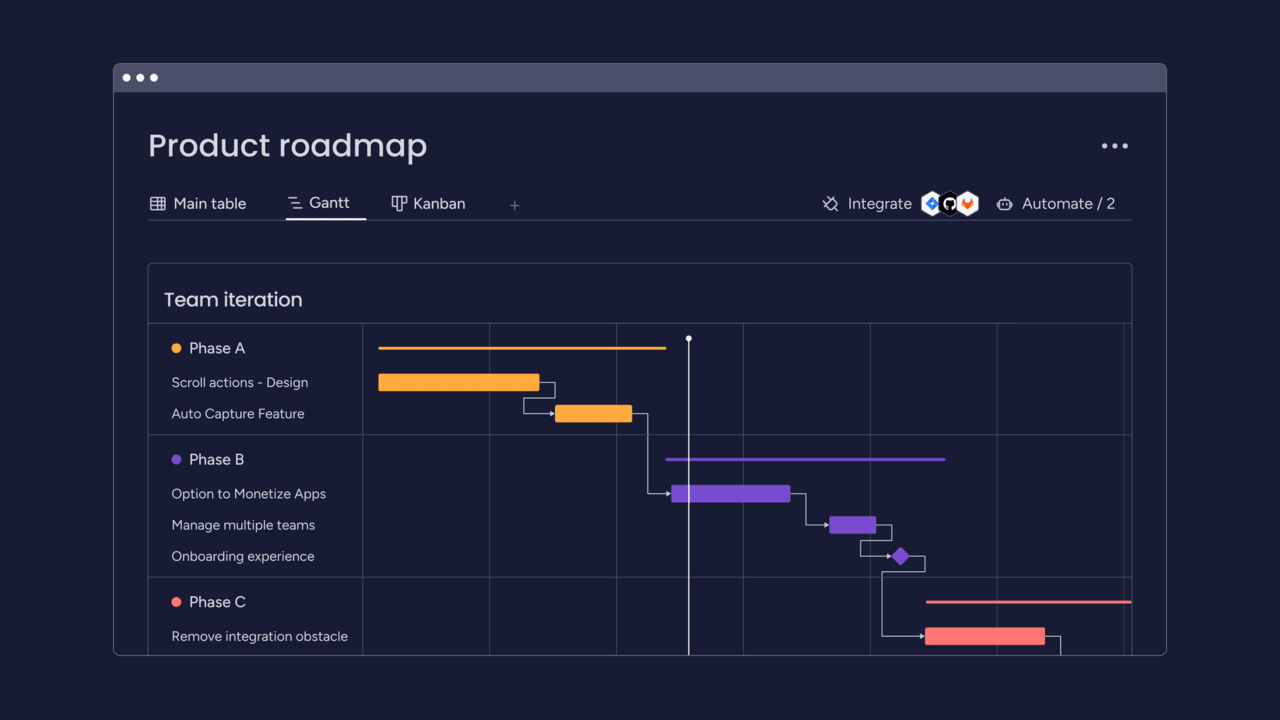
Agile reporting
Agile reporting is the process of tracking and consolidating project data to provide regular updates and insights on a project’s progress. An Agile project manager must track and communicate these project metrics routinely throughout the project so the team can actively consider the data to make informed decisions about the project’s course of action. Agile reports are often presented in visually intuitive graphs or charts, making the information accessible and digestible for all stakeholders.
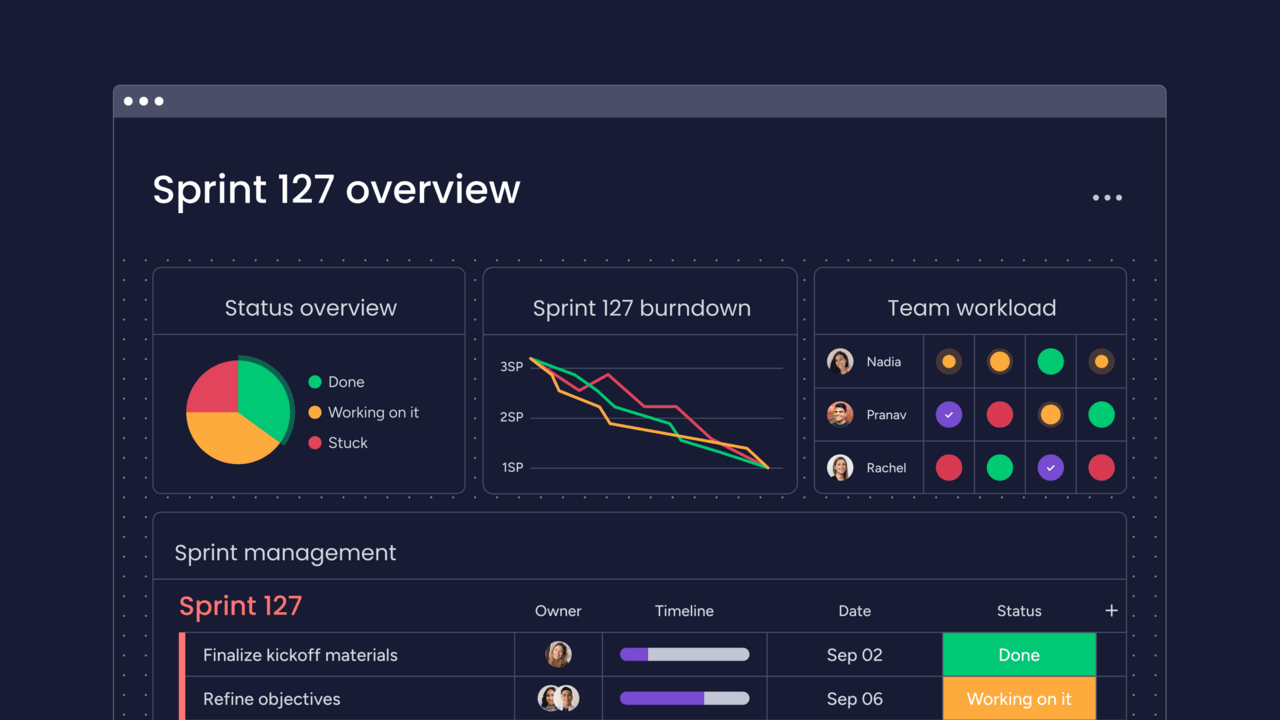
Stakeholder communication
Agile project managers must carefully manage stakeholder communication to ensure that everyone is aligned on the project throughout its course. By creating transparent systems and providing regular updates, project managers can effectively facilitate consistent and clear communication with stakeholders, ensuring effective collaboration. This can include shared documents, planned meetings, and visibility into working systems.
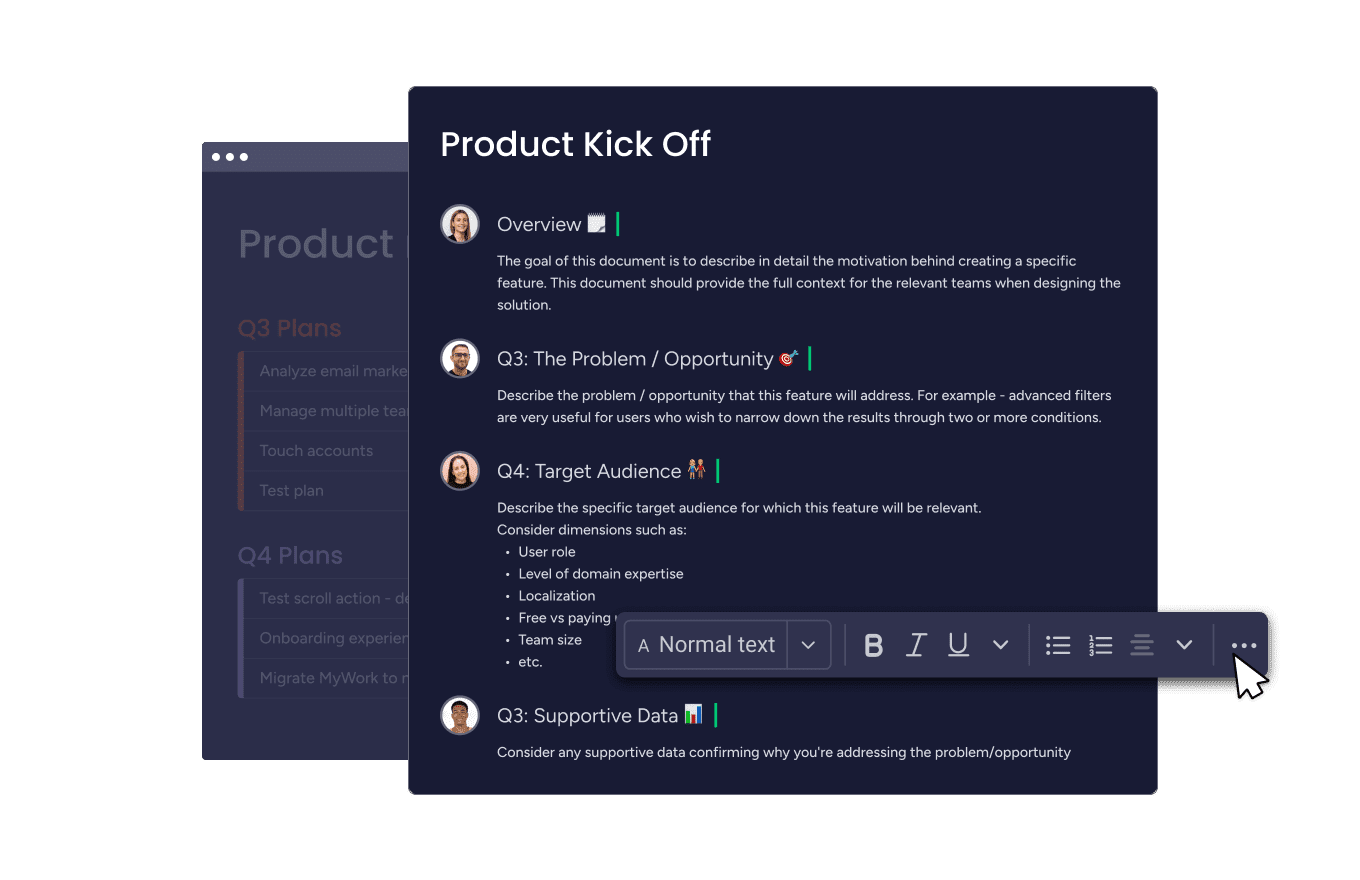
Challenges adopting Agile project management and how to solve them
Although Agile project management is widely adopted, many teams still face hurdles when trying to make it work. Here are some of the most common challenges and how to overcome them.
Unrealistic expectations
- Challenge: Many organizations expect Agile to deliver instant results, but Agile requires cultural and operational shifts that take time to implement and refine.
- Solution: Set clear expectations with leadership and clients. Focus on incremental improvements, continuous delivery, and learning over time, rather than overnight transformation.
Resistance to change
- Challenge: Team members may be attached to familiar processes or skeptical of new workflows, especially if they’ve had success with traditional models.
- Solution: Start small with pilot projects and showcase wins to build momentum. Engage teams early with onboarding, retrospectives, and regular feedback loops to foster buy-in.
Waterfall habits that linger
- Challenge: After adopting Agile, some teams revert to traditional behaviors like long planning cycles, heavy documentation, or rigid approval chains.
- Solution: Invest in Agile coaching and redefine team workflows. Emphasize working in iterations, focusing on MVPs, and empowering cross-functional teams to plan and execute collaboratively.
Overemphasis on tools over principles
- Challenge: While Agile tools can help teams stay organized, they can also become a distraction if the core principles are ignored.
- Solution: Revisit the Agile Manifesto regularly. Encourage open collaboration, regular check-ins, and a focus on delivering value over perfect documentation or process for process’s sake.
Lack of training or talent investment
- Challenge: Without experienced Agile practitioners or proper onboarding, adoption efforts can stall.
- Solution: Provide team-wide training, upskilling opportunities, and mentorship. Bringing in a dedicated Scrum Master or Agile coach can help accelerate adoption and reinforce best practices.
Agile is a mindset more than a methodology, and with the right support, tools, and expectations, teams can overcome these challenges and realize the full benefits of working in an Agile way.
What is the difference between Agile and Waterfall methodologies?
Agile is the opposite of traditional project management styles, such as the Waterfall methodology, where tasks flow in a pre-determined sequence, each dependent on the previous task. These are the key differences between them:
| Methodology | Agile project management | Waterfall project management |
|---|---|---|
| Approach | Takes an iterative approach, with work divided into sprints or cycles | Takes a linear approach, with work divided into distinct phases |
| Emphasis | Emphasizes collaboration, communication, and flexibility | Emphasizes planning, documentation, and adherence to a predefined process |
| Delivery | Prioritizes delivering working software quickly | Prioritizes delivering a fully completed project at the end |
| Requirements | Allows for changing requirements throughout the project | Assumes requirements are fixed at the start of the project |
| Involvement | Requires active involvement from the customer or product owner | Allows for limited customer involvement during the development process |
For a more in-depth comparison, read our Agile vs. Waterfall guide.
Current trends in Agile project management
Agile project management continues to evolve rapidly, shaped by technology, workplace dynamics, and a growing focus on sustainability and adaptability. Here are the current trends:
| Trend | Why it matters |
|---|---|
| AI and automation | Frees teams from manual work, improves decision-making with predictive insights, and accelerates delivery |
| Hybrid Agile frameworks | Offers flexibility by combining structure with adaptability, making Agile more accessible across diverse teams and projects |
| Agile at scale | Extends Agile beyond single teams to the entire organization, increasing alignment and responsiveness across departments |
| Remote/distributed Agile | Enables global collaboration and productivity by leveraging digital tools and async workflows |
| Sustainable Agile practices | Embeds environmental and social responsibility into Agile processes, aligning with long-term business values |
| Data-driven Agile analytics | Supports continuous improvement through real-time performance metrics and smarter forecasting |
| Agile leadership and organizational agility | Builds resilient, responsive teams by encouraging servant leadership, autonomy, and adaptability |
| Focus on soft skills and change management | Enhances collaboration and reduces friction by developing communication, empathy, and trust during transformation |
Agile project management in 2025 is defined by the integration of AI, hybrid and scalable frameworks, remote collaboration, sustainability, data-driven practices, and a renewed focus on leadership and soft skills. These trends enable organizations to deliver value faster, adapt to change, and operate more responsibly and efficiently.
Is Agile project management right for your team?
Agile project management gives teams better visibility into project performance through frequent Scrum meetings and sprint reviews. Although Agile’s roots are grounded in software development, you can use it successfully for projects in any field. In today’s world, every business uses a system to track its progress and accomplish tasks — even if it’s not to produce a physical product.
Agile shortens the work cycle, allowing you to get to market faster while continually adjusting the course to align with market changes.
Use Agile when:
- Project requirements are unpredictable and may change frequently
- Projects are complex and will require frequent iterations
- Frequent feedback to stakeholders or clients is required
- Projects involve a high degree of risk or uncertainty
- Projects are focused on delivering value
Companies like ING, Gore, and Spotify already use Agile project management to handle multiple, interconnected tasks. Why not join them by signing up for a free trial of monday dev to plan your next Agile project?
Try monday devHow monday dev supports Agile project management
Built on monday.com Work OS, monday dev provides development managers with a flexible and powerful AI-powered platform to manage Agile, (Scrum, Kanban), Waterfall, and hybrid workflows at scale. It empowers teams to work their way, accelerate delivery, and maintain complete visibility across every stage of the product life cycle.
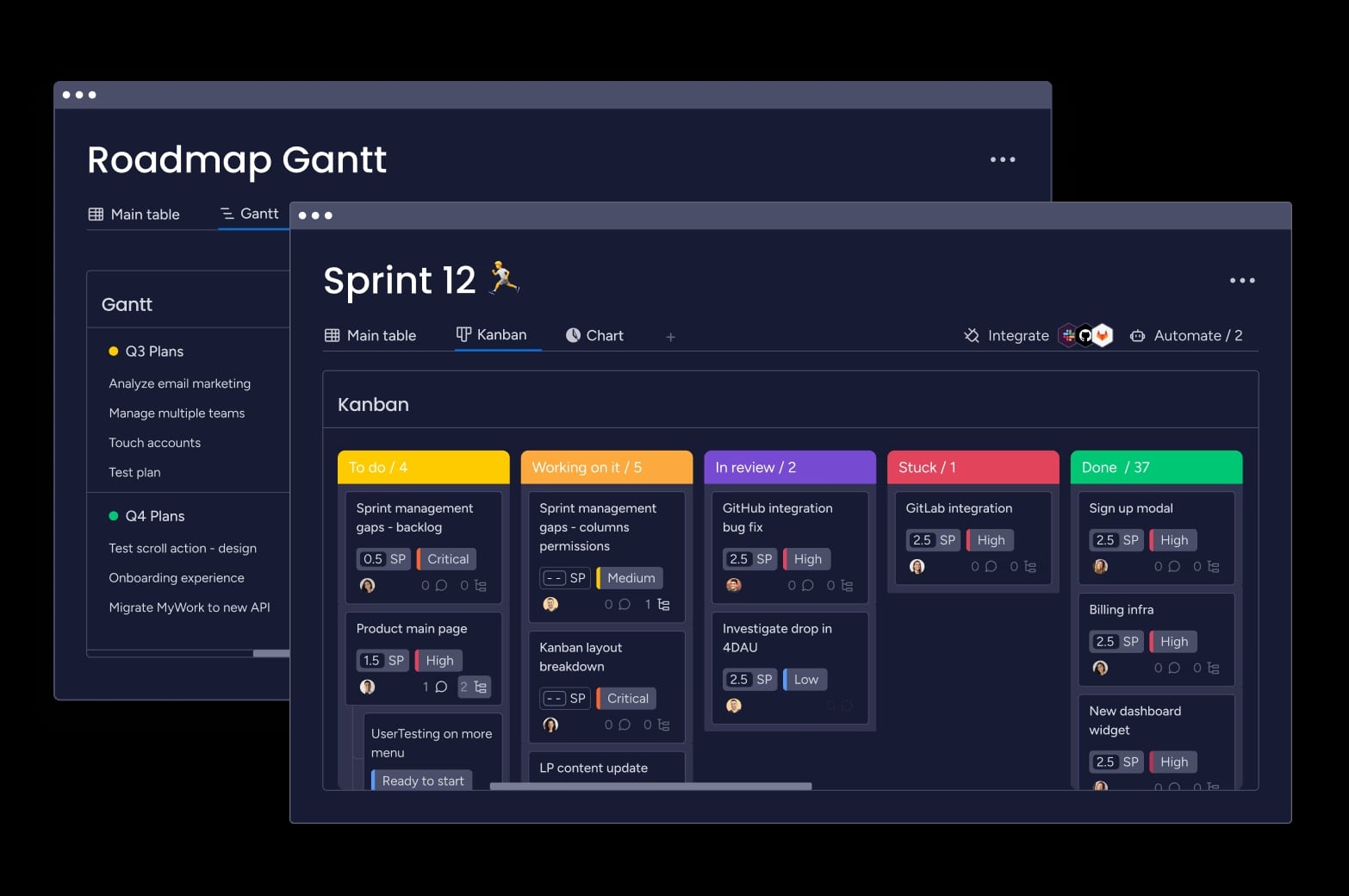
How monday dev supports Agile, Waterfall, and hybrid project management
Let your team work in whatever way is best for them, whether that’s Agile, Waterfall, or a custom hybrid approach. Here’s how monday dev makes it easy to adapt, manage, and scale your project workflows:
- Total flexibility: Fully customize workflows, whether you follow Scrum sprints, Kanban boards, or a hybrid approach, you can adapt the platform to fit your exact process without coding.
- Dedicated Agile templates: Get started quickly with pre-configured boards for Kanban, Scrum (including sprint planning, backlog, and retrospectives), and more.
- Hybrid management: Run Agile and Waterfall projects side by side, track dependencies, and manage portfolios — all within the same environment.
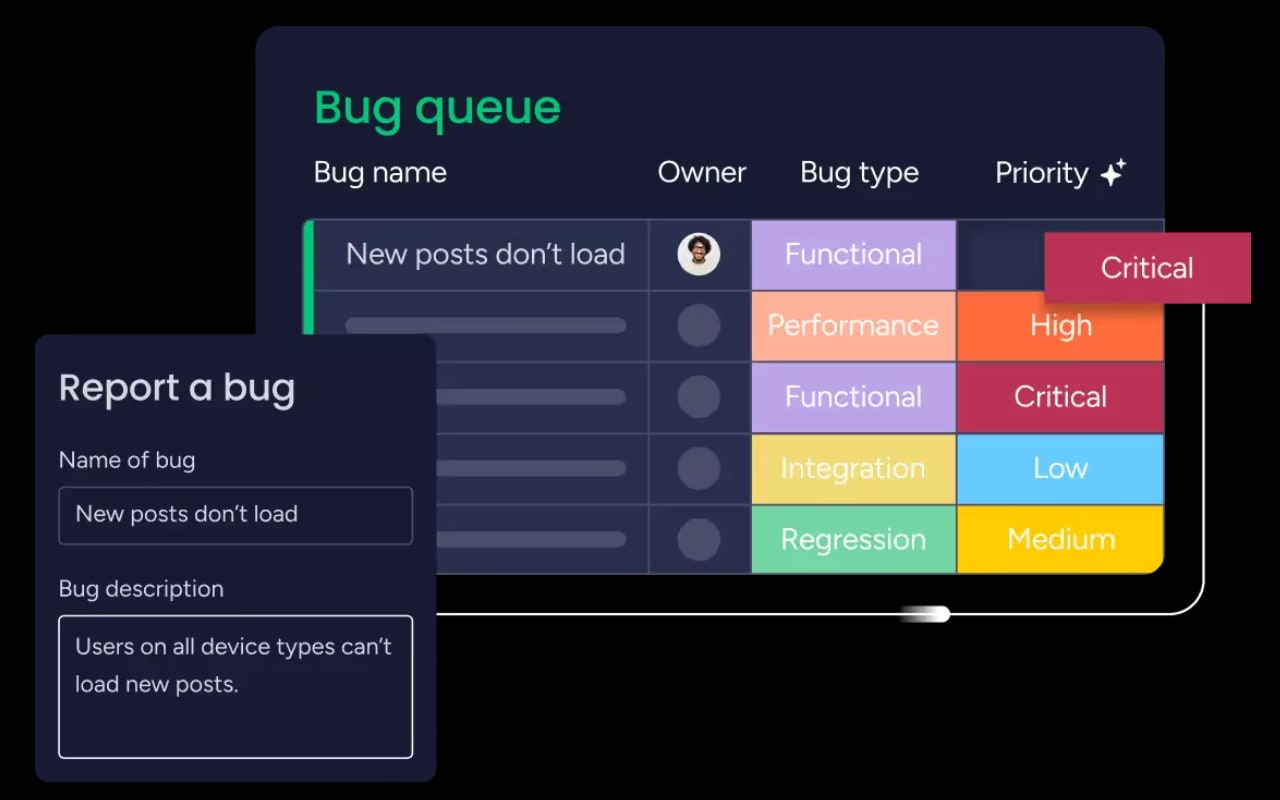
How monday dev uses AI to enhance Agile project management
Work smarter, move faster, and stay focused on what matters. Here are 3 ways AI takes Agile project management to the next level:
- Automated task categorization and assignment: Automatically categorize incoming bugs, requests, or tasks by type, urgency, or sentiment, and assign them to the right owner — saving teams manual effort and ensuring nothing falls through the cracks.
- AI-powered summaries and insights: Instantly summarize complex product documentation, meeting notes, or requirements, giving teams quick, actionable overviews and helping everyone stay aligned without reading through lengthy materials.
- Predictive analytics and risk detection: Identify project risks, forecast sprint velocity, and surface trends in real-time, enabling proactive decision-making and continuous improvement throughout the Agile life cycle.
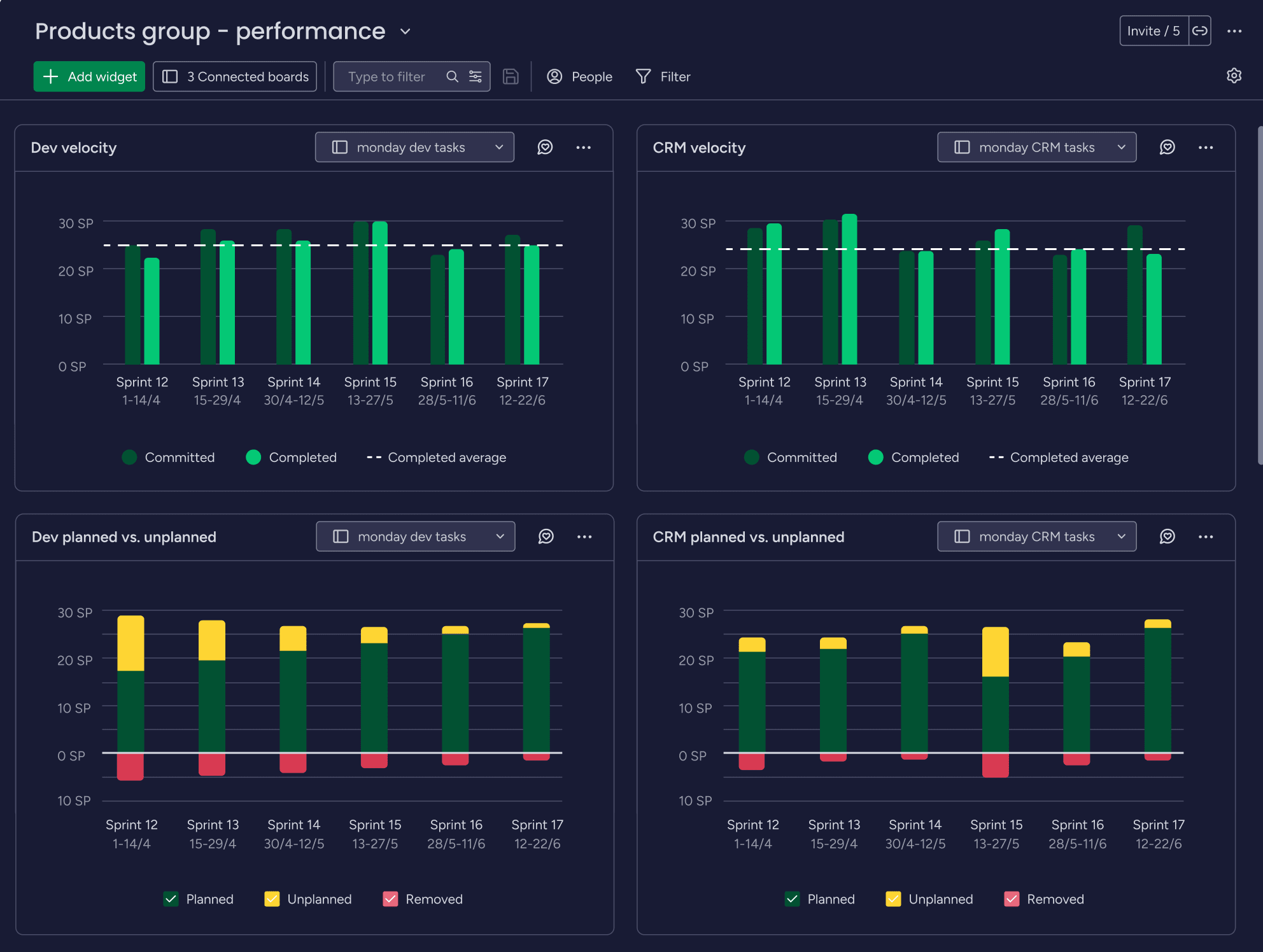
Essential monday dev features for Agile development teams
From sprint planning to stakeholder reporting, monday dev equips Agile teams with the tools they need to stay aligned, move faster, and deliver consistently. Here are the key features that make it a standout solution for development workflows:
- Customizable boards: Visual, drag-and-drop boards let you tailor columns, statuses, and automation to match your workflow — no technical expertise required.
- Robust integrations: Connect with over 200 tools, including GitHub, CircleCI, Slack, and more, using an intuitive, no-code integration hub.
- Dashboards and real-time reporting: Instantly visualize sprint progress, velocity, burndown charts, and portfolio health with built-in dashboards and hierarchy views without add-ons.
- Cross-team collaboration: Unite engineering, product, design, and business teams on one platform, reducing silos and enabling transparent communication and documentation.
- Enterprise-grade security: Protect sensitive data and remain compliant with advanced security features for large organizations.
The bottom line is that monday dev stands out for its flexibility, ease of use, and ability to support Agile, Waterfall, and hybrid methodologies in one place. Unlike other tools like Jira — which often require complex setups, add-ons, and ongoing admin effort — monday dev empowers teams to move fast, collaborate seamlessly, and scale with confidence, all while keeping costs and complexity low.
Ready to see how monday dev can transform your Agile project management? Get started today and experience the difference.
Try monday devAgile PM FAQs
What are the 6 phases of Agile project management?
The exact process will depend on which Agile style you follow but will usually encompass these 6 phases:
- Concept: defining the idea and goals
- Inception: designing the initial plan
- Iteration: developing and testing the deliverables
- Release: releasing the product and tracking progress
- Maintenance: fixing, updating, and adding new features
- Retirement: finalizing the project and closing out activities
What is Agile project management best for?
Agile project management works best for projects that require frequent feedback and ongoing changes. It's also ideal for projects with high levels of complexity and uncertainty.
What are the drawbacks of Agile project management?
Agile project management may not be the best fit for complex projects with multiple dependencies. For example, in an engineering or construction project where everything needs to happen at precisely the right time, full-blown Agile may create bottlenecks. The same applies to highly regulated industries, where you need sign-off before commencing.
Which is better: PMP or Agile?
Neither is universally better — PMP (Project Management Professional) is best for projects needing a structured, plan-driven approach, while Agile excels in environments that require flexibility, rapid delivery, and ongoing customer feedback. The right choice depends on your project’s needs and organizational culture.
What is Agile vs. Scrum in project management?
Agile is a broad philosophy and set of principles focused on adaptability, collaboration, and delivering value iteratively. Scrum is a specific Agile framework with defined roles, ceremonies, and artifacts that provides a structured way to implement Agile principles. In short: Agile is the mindset; Scrum is one way to put it into practice.
What tools are commonly used in Agile project management?
Popular Agile tools include project management platforms (monday dev, Jira, Azure DevOps), collaboration tools (Slack, Microsoft Teams, Trello), continuous integration/delivery tools (Jenkins, GitLab CI/CD), and test management solutions (qTest, Zephyr, TestRail).
How are Agile teams structured?
Agile teams are typically flat, cross-functional, and self-organizing. They include members with diverse skills who work collaboratively, have clear roles and responsibilities, engage in open communication, and have the autonomy to make decisions within their scope.
- Tags:
- Agile methodology
 Get started
Get started 
